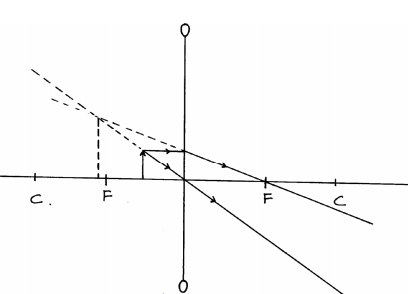Questions
-
- The table below shows the object distance u and the corresponding image distance v of an object placed in front of a convex lens.
u cm 20 25 30 40 50 70 v cm 20 16.7 15 13.3 12.5 11.5 1/u cm-1 1/v cm-1 - Complete the table by giving your answer to 3 d.p.
- Plot a graph of 1/v (y axis) against 1/u
- From the graph, determine the focal length of the lens.
- State any two differences between human eye and the camera.
- The table below shows the object distance u and the corresponding image distance v of an object placed in front of a convex lens.
- A battery is rated 120 Ah. How long will it work if it steadily supplies a current of 4A.
-
- Distinguish between mechanical and electromagnetic waves
- What is the relationship between periodic time and the frequency of a progressive wave
- Complete the diagram below to show the shape of the wave fronts after passing the gap
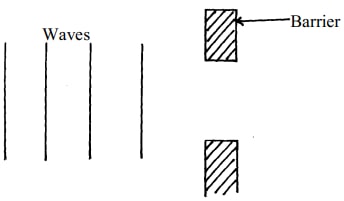
- Complete the ray diagram to show the position of the image
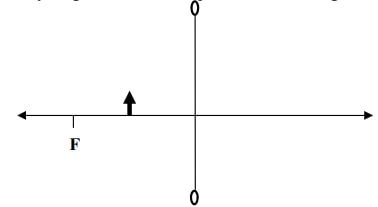
- The figure below shows two mirrors inclined at an angle of 30o to each other. A ray of light is incident on one mirror as shown
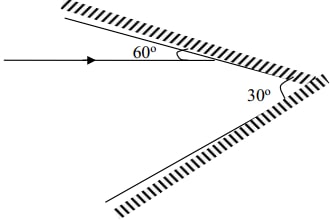
Sketch the path of the ray to show its reflection on the two mirrors - What is meant by the term spherical aberration?
- Complete the ray diagram below by showing the position of the image

State one application of the set up above - A plain sheet of paper and a plane mirror both reflect light yet only the plane mirror forms images. Explain why the paper cannot form images.
- Give one advantage and one disadvantage of using a convex mirror as a driving mirror
- The table below shows the image distance V and the corresponding magnification, M for an object placed in front of a concave mirror.
Magnification M 0.5 1.0 2.0 3.0 4.0 5.0 6.0 Image distance V(cm) 15 20 30 40 50 60 70 - Plot a graph of V (y-axis) against the magnification M
- From the graph, determine the focal length of the mirror
- Given the image IM, locate the position of the object OB. Use arrows to show how the image is formed on a concave mirror
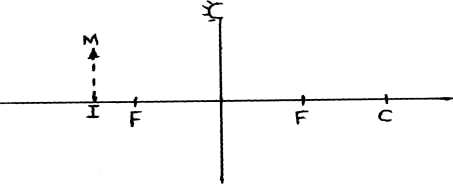
- State the difference between a virtual image formed by a plane mirror and that formed by a concave mirror
- The figure below shows an object O being viewed using two inclined mirrors M1 and M2. Complete the diagram by sketching rays to show the position of the image as seen by the eye-E
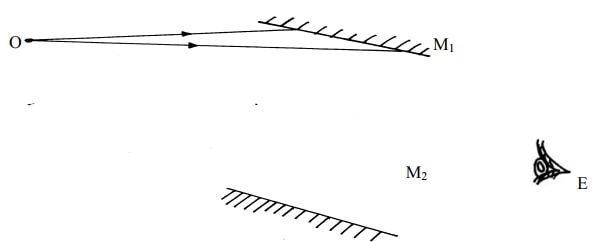
- The figure below shows an object placed in front of a plane mirror. Draw appropriate rays to locate the image as seen by the observer.

-
- Define the following terms as used in curved mirrors:-
- Principal focus (F)
- Focal length (f)
- By use of a ray; diagram, show how a concave mirror may be a dentist mirror
- An object is placed 12cm from a convex mirror of radius of curvature 20cm. Calculate the position of the image
-
- A lady holds a large concave mirror of focal length 1.8m from her face. State two characteristics of her image in the mirror
- A boy is standing between two cliffs A and B but nearer to cliff A than B. He stands 160m from wall BA and shouts once. He hears two echoes and discovers that the time between the two echoes is 0.8 seconds. Determine how far the boy is standing from cliff B given that the speed of sound in air is 340m/s
- Define the following terms as used in curved mirrors:-
Answers
-
-
-
1
u0.05 0.04 0.033 0.025 0.020 0.014 1
v0.05 0.06 0.67 0.75 0.080 0.086
Any 4 correct values = 1 mk
Total = 3 mks - Any intercept = 1 mk
Rec. – 1 mk
Arrange of Reciprocal – 1 mk - f = 10 + 1 cm
-
- – Focal length of eye lens is variable while that of camera is fixed. ✓1 mk
- Eye has constant image distance. ✓1 mk
-
- 120 = 4t
t = 120/4 ✓ 1 mk
= 30 hrs ✓ 1 mk -
- Mechanical waves – require medium for propagation
Electromagnetic can even travel in a vacuum (No medium required) - Frequency = 1/periodic time
-

- Mechanical waves – require medium for propagation
Extrapolation of light rays backwards
Dotted and upright change formed between C and F- Reflected rays shown by arrow pointed correctly angles marked as
i= r = 30o and i = r = 0 (implied)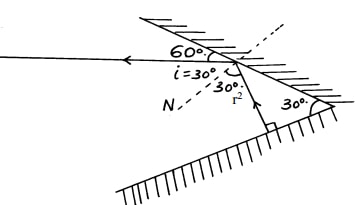
- Spherical aberration is a situation where rays parallel but far away (distant) from the principal axis of a concave mirrors fails to pass through its focal point owing to the large radius of curvature of the mirror
- Complete the ray diagram below by showing the position of the image.
-It is used as a simple microscope or magnifying glass in the laboratory. - - The reflection is a sheet of paper is irregular hence rays interfere with formation of images
- Reflection in a plane mirror is regular - Advantage: wide field of vision
Disadvantages: Gives a wrong impression of the position of image due to the diminished image formed -
- Image V distance( Vcm)
Axes ✓
Scale ✓
Plotting all values ✓
Plotting at least 5pts ✓
Line ✓
Magnification M✓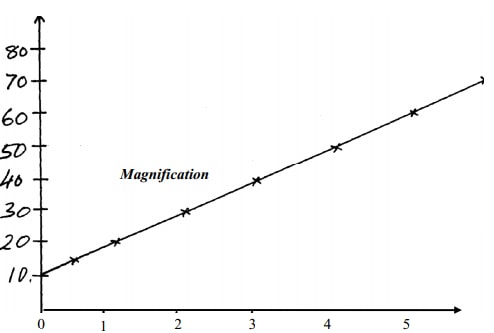
- From the graph
V = mf + f
f = V – intercept
= 10cm
OR
f = gradient
= 50 – 20
4 – 1
= 30/3
= 10cm -
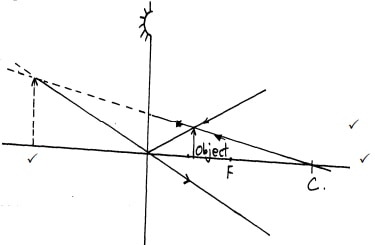
Correct rays with arrows
Object between P and F
- Image V distance( Vcm)
- Image formed by concave mirror is enlarged while that formed by plane mirror is same size as object
-
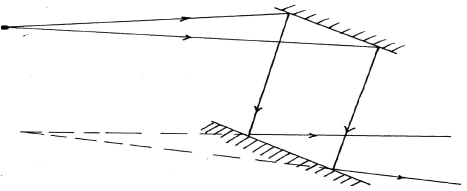
-

-
-
- Point on the principal axis to which all rays originally close and parallel to the principal axis passes after reflection.
- Focal length (f) – distance between the pole of the mirror (centre of the mirror) and the principal focus f
-
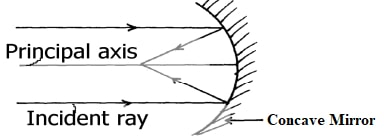
-
- u = +12cm, f = +10cm, v=?
1/f = 1/u + 1/v , 1/10 – 1/12 = 1/v
12 – 10 = 2
120 120
∴ V = 120/2 = 60 cm
∴ Image distance = 60cm
- u = +12cm, f = +10cm, v=?
-
- Enlarged, virtual, upright(any two)
-
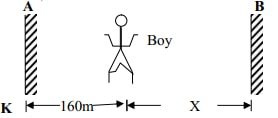
2x – 320 = 0.8
340 340
2x – 0.94 = 0.8
340
2x = 1.74
340
2x = 591.6
x = 295.8 m
Let the distance between the boy and the cliff be X and speed of sound in air is 340m/s
-
Download Reflection at Curved Surfaces and Spherical Surfaces Questions and Answers - Physics Form 2 Topical Revision.
Tap Here to Download for 50/-
Get on WhatsApp for 50/-
Why download?
- ✔ To read offline at any time.
- ✔ To Print at your convenience
- ✔ Share Easily with Friends / Students

